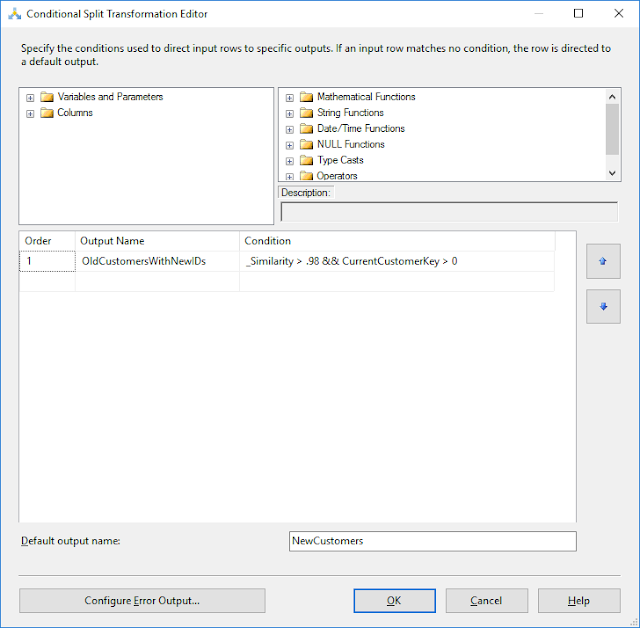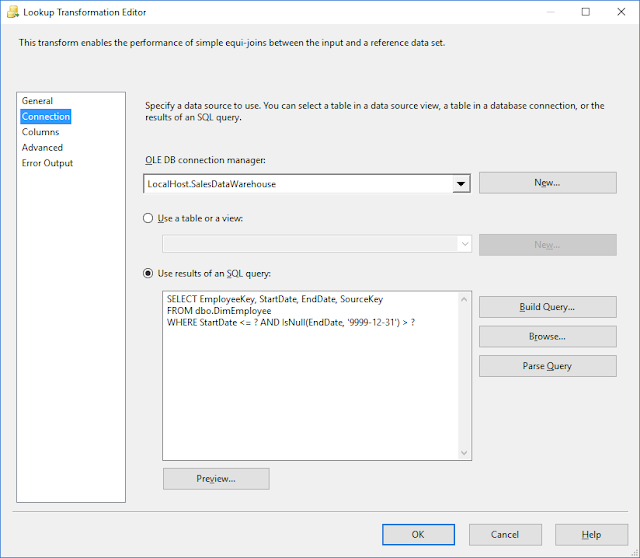The next code is for loading some sample records. Note that
DimDate is loaded with
WideWorldImportersDW database as its date dimension table contains records for the current year. However, this can be loaded using a simple script as well.
Have a look on records related to
DimEmployee. Since it is a SCD Type II dimension, it holds history records. As you see, there are two records to
James Phil with validity period.
-- Inserting date records from AdventureWorks table
INSERT INTO dbo.DimDate
(DateKey, [Date], [Month], MonthNumber, QuarterName, QuarterNumber, [Year])
SELECT CONVERT(int, CONVERT(varchar(8), [Date], 112)), [Date], [Month], [Calendar Month Number]
, 'Quarter ' + CONVERT(varchar(2), DATEPART(Q, [Date])), DATEPART(Q, [Date]), [Calendar Year]
FROM WideWorldImportersDW.Dimension.Date;
-- Inserting records to Customer
INSERT INTO dbo.DimCustomer
(FullName, Town, SourceKey)
VALUES
('Jane Knight', ' Town 1', 100)
, ('Jack walter', 'Town 2', 101);
-- Inserting records to Product
INSERT INTO dbo.DimProduct
(Product, Brand, SourceKey)
VALUES
('Product 1', ' Brand 1', 22)
, ('Product 2', 'Brand 3', 23);
-- Inserting records to Customer
INSERT INTO dbo.DimEmployee
(Name, SalesTown, StartDate, EndDate, IsCurrent, SourceKey)
VALUES
('Peter Kevin', 'Town 1', '2016-06-01', null, 1, 200)
, ('James Phil', 'Town 2', '2016-06-01', '2016-06-30', 0, 201)
, ('James Phil', 'Town 3', '2016-06-30', null, 1, 201);
Next code is for creating the
Fact table. Generally,
Fact Table is a partitioned table. Therefore, this code creates a partition function and scheme for it. Note that, the best practice is, have different
File Groups for partitions but let's just use
PRIMARY (I will be discussing partition switching on fact loading with another post, extending the same code).
-- creating the partition
CREATE PARTITION FUNCTION pf_SalesDate (int)
AS RANGE RIGHT
FOR VALUES (20160101, 20160201, 20160301, 20160401, 20160501, 20160601, 20160701)
GO
-- creating the scheme
CREATE PARTITION SCHEME ps_SalesDate
AS PARTITION pf_SalesDate
TO ([PRIMARY], [PRIMARY], [PRIMARY], [PRIMARY], [PRIMARY], [PRIMARY], [PRIMARY], [PRIMARY])
GO
CREATE TABLE FactSales
(
DateKey int NOT NULL INDEX IX_FactSales CLUSTERED,
ProductKey int NOT NULL,
CustomerKey int NOT NULL,
EmployeeKey int NOT NULL,
SalesAmount money NOT NULL,
SalesQuantity smallint NOT NULL
)
ON ps_SalesDate (DateKey)
GO
Let's insert some sample records into the
Fact Table too.
INSERT INTO FactSales (DateKey, ProductKey, CustomerKey, EmployeeKey, SalesAmount, SalesQuantity)
VALUES
(20160605, 1, 1, 1, 500, 2)
, (20160615, 2, 2, 1, 500, 2)
, (20160622, 2, 2, 2, 500, 2)
, (20160624, 2, 1, 1, 500, 2)
Done, now we have to create a SSIS package for loading new records. As you noted, we have records related to June 2016, and we will be loading records related to July 2016. Let's use following recordset for loading the
Fact Table.
SELECT CONVERT(date, '2016-07-01') As TransactionDate, 22 AS ProductId, 100 AS CustomerId, 200 AS EmployeeId, 500 AS SalesAmount, 2 AS SalesQuantity
UNION ALL
SELECT CONVERT(date, '2016-07-12') As TransactionDate, 23 AS ProductId, 101 AS CustomerId, 200 AS EmployeeId, 500 AS SalesAmount, 2 AS SalesQuantity
UNION ALL
SELECT CONVERT(date, '2016-07-14') As TransactionDate, 23 AS ProductId, 100 AS CustomerId, 201 AS EmployeeId, 500 AS SalesAmount, 2 AS SalesQuantity
UNION ALL
SELECT CONVERT(date, '2016-07-22') As TransactionDate, 22 AS ProductId, 100 AS CustomerId, 201 AS EmployeeId, 500 AS SalesAmount, 2 AS SalesQuantity
Let's create a SSIS package and add a connection to the data warehouse. I have a database named
Sales and will be using it as the source even though we do not extract records from the source. As you see, I have a
DataFlow Task in the
Control Flow.
Since we do not get surrogate key values from the source, we need to have
Lookups for dimension tables for getting surrogate key values. As you see with the image below, I have added
OLEDB Source to connect with
Sales and four of
Lookups for getting surrogate key values related to Date, Customer, Employee and Product.
Let's have a look on source first. It is configured with
Sales database and the query above is used for populating required records.
There are three
Type I type dimensions. Let's have a look on one and see how it needs to be checked. In order to get
DateKey from the
DimDate dimension, we need to look up
DimDate by using
TransactionDate that comes with the source. We need to configure the lookup to
DataWarehouse connection and select the lookup table as
DimDate. Once the connection is set, we need to link
TransactionDate coming from the source with
Date in the dimension. We need to select
DateKey as it is the one we need when we insert records to the
Fact Table. The selected
DateKey is added to the flow automatically.
The similar configuration is required for
DimCustomer and
DimProduct for getting surrogate key values. We need to link
CustomerID of the source to
SourceKey in the
DimCustomer table and get the
CustomerKey. We need to link
ProductID of the source to
SourceKey in the
DimProduct table and get the
ProductKey. However, getting
EmployeeKey is different as it is as SCD Type II dimension. Let's have a look on the configuration of
Employee Lookup.
I will take you through the steps required for configuring this. First we need to make sure that
Cache mode is set to either
Partial Cache or
No Cache because we are going to parameterize the lookup query.
Next is setting up the connection. We need to connect it to
DataWarehouse and use a query for loading dimension records. Note the way it has been written. I have used question marks for parameterizing the query as we need to pick the right record related to the
TransactionDate.
Just like the other dimensions, we need to match two columns from the source and dimension to find the record. However, additional link is required for getting values for parameters, hence need to link
TransactionDate with
StartDate though that is not the exact link we need.
You will see the reason for joining
TransactionDate and
StartDate with next step. We need to adjust the lookup query now, need to do it with
Advanced section. It is required to adjust the query like below.
Once adjusted, need to set parameters like below. It allows us to select
TransactionDate as a parameter value because the above join. Note that parameters a
0-based indexed.
All done, finally it needs the destination. Set
OLEDB Destination for loading the
FactSales as the last step the of the
DataFlow task. Once all configurations are done, you can run the package and see how the
FactSales has been loaded.

















































